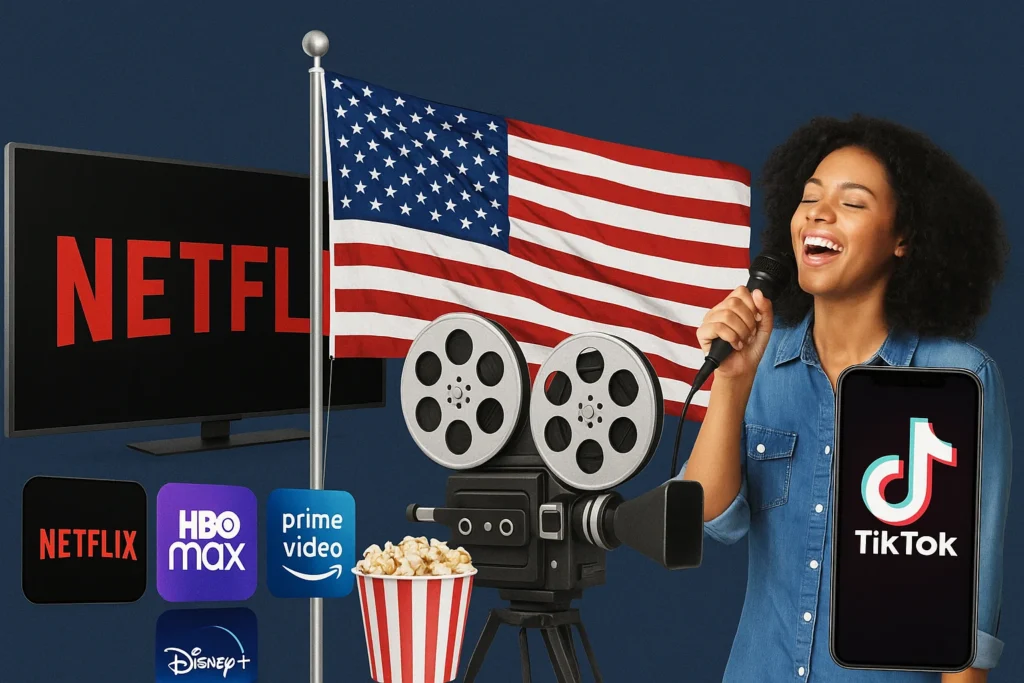Introduction: From Hollywood Hills to Your Hometown
Have you ever found yourself humming along to an American pop song, quoting a line from a Hollywood movie, or binge-watching a U.S. TV show on a streaming service? If so, you’ve experienced firsthand the incredible reach of American culture. From fashion and food to music and movies, ideas born in the United States often find their way into homes and hearts around the globe. It’s like America has a powerful amplifier, broadcasting its stories and trends to every corner of the planet.
But how did this happen? And what does it look like in today’s fast-paced, digital world, especially with new technologies and shifting global relationships? We’ll dive into the fascinating story of American cultural exports, exploring how U.S. dominance in global streaming is changing what we watch, why some apps like TikTok face big challenges, and how music and movies keep evolving to capture imaginations worldwide.
The Reign of the Streamers: American Dominance in Your Living Room
Not long ago, if you wanted to watch a movie, you went to a cinema or rented a DVD. If you wanted to see a TV show, you waited for it to air on a local channel. Today, our screens are filled with choices, and much of that choice comes from American streaming giants. Companies like Netflix, Disney+, and Amazon Prime Video have truly changed the game, becoming global powerhouses.
How Streaming Conquered the World
Imagine a giant library filled with thousands of movies and TV shows, available instantly, anytime, anywhere. That’s what these streaming services offer, and they’ve aggressively expanded their reach beyond U.S. borders. Netflix, for example, is available in over 190 countries, and a huge chunk of its subscribers are now outside North America. Disney+ and Amazon Prime Video also boast hundreds of millions of subscribers worldwide, making them household names from Mumbai to Manchester.
- Vast Libraries: These platforms pour billions of dollars into creating original content, from blockbuster movies to hit TV series like “Stranger Things” or “The Mandalorian.” They also license popular shows and films, giving subscribers an unmatched variety.
- Convenience: The ability to watch what you want, when you want, on almost any device (TV, phone, tablet, computer) is a massive draw. No more waiting for showtimes or worrying about missing an episode.
- Affordability: Compared to traditional cable TV packages, streaming services often seem like a bargain, offering huge amounts of entertainment for a relatively low monthly fee.
This American dominance in global streaming means that stories, characters, and trends born in Hollywood often become globally recognized very quickly. This powerful influence isn’t just about entertainment; it shapes conversations, fashions, and even values across different cultures.
Hollywood’s Enduring Magic: From Silver Screen to Global Screens
Even before streaming, American movies and music had a special place in the world. Hollywood, the heart of the U.S. film industry, has been churning out blockbusters and beloved classics for over a century. From epic adventures to heartwarming comedies, Hollywood trends often set the pace for the rest of the world.
The Power of Storytelling
American movies have a unique ability to tell stories that resonate with people everywhere. Whether it’s the hero’s journey in an action film, the relatable struggles in a drama, or the universal humor in a comedy, these narratives often transcend language and cultural barriers. Think about how superhero movies, spy thrillers, or animated films become global phenomena, with characters recognized by kids and adults alike, no matter where they live.
- Big Budgets, Big Spectacle: Hollywood often has the resources to produce films with stunning visual effects, elaborate sets, and famous actors, creating an unparalleled cinematic experience that draws audiences worldwide.
- Marketing Might: U.S. film studios also have massive marketing machines that promote their films across continents, ensuring that global audiences know about upcoming releases.
- Genre Innovation: Hollywood has a history of innovating within genres, creating new ways to tell stories that are then adopted and adapted by filmmakers in other countries.
This continuous flow of American films and TV shows through streaming and cinemas helps maintain the U.S.’s leading role in the global entertainment industry, making its cultural narratives a familiar part of the international landscape.
The Beat Goes On: American Music’s Global Reach
If Hollywood is America’s visual ambassador, then music is its rhythmic heartbeat, reaching across borders and uniting diverse audiences. From the birth of jazz and blues to the global explosion of rock and roll, hip-hop, and pop, American music has continuously shaped global trends and captured the imagination of listeners worldwide.
Sounds That Cross Oceans
Consider how artists like Taylor Swift, Beyoncé, or Billie Eilish dominate global music charts, their songs becoming anthems in countries far from the U.S. This isn’t just about catchy tunes; it’s about the unique blend of sounds, powerful lyrics, and compelling artistry that often originates in the American music scene.
- Innovation: American artists and producers have a long history of experimenting with sounds and genres, constantly pushing boundaries and creating new musical styles that then influence artists globally.
- Global Distribution: With the rise of digital music platforms like Spotify, Apple Music, and YouTube, American music is instantly available to billions of listeners worldwide. These platforms have significantly amplified the reach of U.S. artists.
- Cultural Fusion: While distinctly American, many music genres (like hip-hop) draw on diverse cultural influences, making them relatable and appealing to a wide international audience. Lyrics often touch on universal themes of love, struggle, triumph, and identity.
- Visual Storytelling: Music videos, especially from American artists, are often cinematic productions that contribute significantly to the song’s popularity and cultural impact, turning songs into global spectacles.
This continuous influence means that American music acts as a powerful cultural export, not just entertaining, but also influencing fashion, dance, and youth culture around the world.
The TikTok Tangle: A New Kind of Cultural Exchange, A New Kind of Challenge
While American streaming and music have long dominated, a newer player emerged from China that quickly captured global attention: TikTok. This short-video app became a massive cultural phenomenon, especially among younger generations, influencing trends, challenges, and even how music becomes popular. Suddenly, it wasn’t just American culture flowing outwards; content from all over the world, shared on TikTok, was influencing U.S. trends too.
Why TikTok Faced Trouble
Despite its immense popularity (or perhaps because of it), TikTok found itself in hot water, particularly in the U.S. and other Western countries. The main reason? National security concerns.
- Data Security: The U.S. government, and some other nations, worried that because TikTok’s parent company, ByteDance, is based in China, the Chinese government could potentially access U.S. user data or influence the content people see on the app. They feared this could be used for espionage or to spread propaganda.
- Content Influence: There were concerns that the algorithms deciding which videos users see could be manipulated by a foreign government to push certain narratives or suppress others.
- User Data: The sheer amount of data TikTok collects on its users (like what they watch, how long they watch it, their location, and more) also raised privacy alarms.
These concerns led to serious discussions and even proposed TikTok bans or requirements for the app to be sold to a U.S. company. It shows how cultural influence in the digital age is deeply tied to questions of technology, data, and national security.
Beyond TikTok: The Search for Alternatives and What’s Next
The challenges faced by TikTok have sparked a frantic search for TikTok alternatives and highlighted how quickly the digital landscape can shift. When a popular platform faces a potential ban, users and creators naturally look for new homes.
The Rise of Competitors and New Formats
- Instagram Reels & YouTube Shorts: Seeing TikTok’s success, major American tech companies quickly launched their own short-video features. Instagram’s Reels and YouTube Shorts exploded in popularity, giving creators familiar platforms to share their content. These offer similar short-form video formats but are owned by U.S.-based companies, addressing some of the security concerns.
- Snapchat & Triller: Other apps also continued to compete, offering various forms of short-form video or unique social media experiences.
- Decentralized Platforms: Some people are even exploring more decentralized or open-source platforms, hoping for greater privacy and less corporate or government control.
This competition is a good thing for users, as it drives innovation and gives creators more choices. It also means that the flow of cultural trends can become more diverse, as different platforms cater to different communities and content styles. The “streaming wars” aren’t just for long-form content; they’re happening in the world of short videos too.
The Future is Now: AI Influencers and the Evolution of Media
As technology continues to advance at lightning speed, American cultural exports, and indeed global media, are entering a fascinating new era. One of the most intriguing developments is the rise of AI influencers and the increasing role of artificial intelligence in creating music and movies.
When Code Becomes Creativity
Imagine a pop star who isn’t a real person, but a computer-generated character with millions of followers. Or a hit song composed by an AI. This might sound like science fiction, but it’s becoming a reality.
- AI Influencers: These are virtual characters, created using computer graphics and AI, who have personalities, “lives,” and interact with followers on social media. They can promote products, create content, and even “perform” music. Lil Miquela, for instance, is a well-known AI influencer with millions of followers, collaborating with major brands. This trend, heavily influenced by tech innovation often stemming from the U.S., challenges our ideas of authenticity and celebrity.
- AI in Music: AI can now compose original melodies, generate lyrics, and even mimic the style of famous artists. While still evolving, AI tools are increasingly used by human musicians to assist in production, remixing, and even creating entire soundtracks for films.
- AI in Movies: Beyond special effects, AI is being used in filmmaking for everything from script analysis (predicting what audiences might like) to generating realistic visual effects, creating virtual actors, or even assisting with editing and post-production.
These advancements raise exciting questions about creativity, ownership, and the future of human artistry. While AI tools are global, much of the research and development in this cutting-edge area originates from American tech companies and universities, further cementing U.S. influence in how cultural content is created and consumed.
Streaming Wars and Beyond: What’s Next for Global Entertainment?
The “streaming wars” are not just a battle for subscribers; they’re a battle for cultural influence. As more companies enter the streaming market, and as technology evolves, the way we consume and interact with entertainment is constantly changing.
The Landscape of Tomorrow
- Personalization: AI will play an even bigger role in recommending content, creating highly personalized viewing experiences for users based on their preferences.
- Interactive Content: We might see more choose-your-own-adventure style movies or shows, allowing viewers to directly influence the storyline.
- Virtual Reality (VR) and Augmented Reality (AR): These technologies could make entertainment even more immersive, allowing users to “step inside” movies or attend virtual concerts.
- Global Collaboration: While American cultural exports remain powerful, there’s also a growing appreciation for diverse content from around the world. Streaming platforms are increasingly investing in and promoting international shows, leading to more cultural exchange. Think of Korean dramas or Spanish-language series gaining massive global popularity.
The future of entertainment will likely be a blend of continued American innovation and a more vibrant, interconnected global cultural landscape, where ideas and stories flow in many directions.
Conclusion: The Enduring Influence and Evolving Landscape
The rise of American cultural exports is a story of powerful storytelling, technological innovation, and savvy marketing. From the enduring magic of Hollywood movies and the global beat of American music to the pervasive reach of streaming services, U.S. culture has shaped how billions of people entertain themselves, connect, and understand the world.
However, this dominance isn’t static. The rise of new platforms like TikTok, and the debates they spark, show that cultural influence is a dynamic, sometimes contested, space. And the emergence of technologies like AI influencers hints at a future where creativity and content are generated in ways we are just beginning to understand.
Ultimately, American culture continues to play a massive role on the global stage, adapting to new technologies and trends while its core narratives and sounds resonate with audiences worldwide. The beat goes on, and the screen keeps glowing, connecting us all in this ever-evolving global story.



